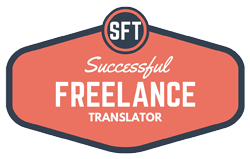Do you have a business model for your freelance translation business? No? Then it is high time to think about it if you treat your business seriously and want to succeed. In this post, you will learn how to develop a comprehensive, flexible and dynamically adaptable business model for your freelance translation business. Perhaps you’re just starting your way in freelancing and suffer “feast or famine cycles” going from one occasional client to another. Or you already have several clients, either direct or translation agencies, to make a living.
In both cases, without a system, it is hard to achieve sustainable growth or, at least, to ensure a stable income. Therefore, it is worth spending some time to develop a business model that will help you to shape up the general concept of your business and determine development trends.
This post is based on a Business Model Generation canvas by Alex Osterwalder. You can start building your business model for freelance translation business using online tool. You can access it anytime and update relevant information on the go.
Reducing the business model to simple statements, you will have to provide the answers for the following questions:
- Who are your customers?
- What can you give them?
- How can you do that?
- How much will it cost?
Let’s start with the first question and determine your customers.
Customer Segments
Know your customer – this is not just a cool slogan but a key concept of any business. It is very hard to build a successful business without a clear understanding of who your customers are. You can start with determining large groups of segments such as agencies, private persons, direct clients and go down to smaller segments into each group.
For instance, agencies can be subdivided into:
- Large established translation agencies
- Specialized (boutique) translation agencies
- Startup translation companies.
Choosing direct clients as you customers you should find your niche depending on specialization. For example, I offer English-Russian technical translations service in the field of mining, construction and power supply. My target customers are equipment manufacturers, construction companies, energy utilities, R&D institutes, etc.
Try to determine your potential clients as detailed as possible, but don’t be afraid to cross out some of them in future. This is just a hypothesis that needs to be proved. During the further work on your business model you will understand who are your actual customers and who are not.
Customer Relations
After you have determined your customers, think about what type of relations your customers might be expecting. To my best knowledge, translation customers usually expect that you reply to the inquiries fast, provide reliable and quality services, as well as timely support with regard to all related issues.
Value Proposition
After you determine your customers and the way you want to establish and maintain relations with them, you may proceed to the development of a unique value proposition. To develop UVP you should answer two main questions:
- How your services solve customers’ problems?
- Why your services are better than services rendered by other providers?
I have already written about it in my previous post in “Determine your unique value proposition” paragraph.
Channels
You already know your customers, how to cooperate with them and what you can offer. Now the question is how you can reach your customers. There are many ways to reach customers using conventional (direct marketing: emails, calls, offline ads, etc.) or modern marketing methods (online marketing: website + SEO, online advertising, SMM, etc.). It is hard to provide a universal answer to the question which method works better for freelance translation business. Try to identify what works best for you.
Key Activities
You did a great job already if you reached this paragraph! Now you should think about how you can make all that things work. Write down the entire service delivery process: ordering and registration, signing agreements, pre-translation and translation activities, project delivery and payment arrangements. Try to be as specific as possible and write each activity pertaining to your business.
Key Resources
Now determine what you need to have all things running. Resources will include not only physical assets like PC, printer, scanner, etc. but intellectual resources as well: software, legal registration, website, membership in organizations, etc.
Key Partners
Reliable partners play an important role in every business. Collaboration is a key concept of freelancing, therefore, you should try to find good partners that will supplement and add value to your business. For instance, you may establish a contact with a local public notary to render notarization services and get a good discount for bulk orders, or conclude a contract with web development company to enhance the range of their services and help their clients with website translation.
Cost Structure
Finally, we arrived at the important question – how much will it cost? Price formation is a fine question that requires specific attention. It is hard to cover all nuances related to this process in one post, therefore, here I would like to focus your attention on the costs related to your business model. Write down how much you need to pay for key resources and how much you will have to spend for main activities. This will help you to understand how much it will cost to run the business.
Then you need to determine your pricing model. Translators and agencies use different pricing models with most common being per word, per page and per hour models. Choose what suits your needs better. You may use this translator rates calculator by Proz.
Then set up realistic annual revenue rate. Calculate how much you need to cover your living expenses and find out how much will remain as net profit. Conduct a market research to find out the prices of your competitor to avoid charging too much or too low for your services.
Now you have a customized business model ready for your freelance translation business. But remember, your business model is not a rigid framework, it is a dynamically forming and developing concept that can and should be adjusted depending on current conditions. Keep on experimenting: try to cover new markets, offer better services, use new technologies, and reach new heights!



